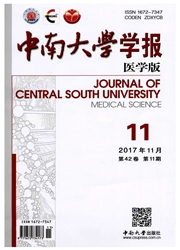

 中文摘要:
中文摘要:
目的:筛选直肠癌组织异常表达的miRNAs。方法:采用miRCURY“基因芯片(v.14.0)分析直肠癌组织和邻近非肿瘤组织之间差异表达的miRNA,设定平均上升或下降倍数大于2倍和P值小于0.05为差异标准。结果:88个miRNAs表达显著上调,其中46个基因已证实在结直肠癌组织中表达升高;40个miRNAs表达显著下调,其中15个已报道在结直肠癌组织中表达异常降低。实时定量PCR(RT-qPCR)结果显示:6个表达上调的miRNAs在直肠癌组织中也异常高表达,与基因芯片结果比较,表达水平相差从-11.88%至39.09%;同样6个表达下调的miRNAs在肿瘤组织中也呈低表达,与基因芯片结果比较,表达水平相差从1.35%至29.35%。基因芯片与RT,qPCR两方法分析的结果呈高度相关(r=0.96,P〈0.01)。结论:相对于混合样本(结直肠癌)miRNA表达谱,直肠癌miRNA表达谱呈现出明显的特异性;同时鉴定了一系列新的异常表达的miRNAs。
 英文摘要:
英文摘要:
Objective: To identify aberrantly expressed miRNAs in rectal cancer. Methods: We used the miKCUKY Array LNA microRNA chip (v.14.0) to evaluate miRNA expression levels between rectal cancer tissues and adjacent non-tumor tissues; an average change more than 2-fold (and P value less than 0.05) was set as a cutofflevel. All 6 paired rectal cancers were classified pathology stage C or D. Results: Eighty-eight miRNAs were up-regulated and 46 miRNAs have been reported in colorectal cancer; 40 miRNAs were down-regulated in rectal cancers and 15 miRNAs have been reported in colorectal cancer. To compare the relative miRNA expression levels as measured by RT-qPCR and chip analysis, we analyzed expression levels of these miRNAs in the cancer tissues. l-he results showed that miRNA expression (increased or decreased) in the paired benign and tumor tissue wasconsistent between the two methods in all cases. Expression levels of 6 up-regulated miRNAs (by chip analysis compared to RT-qPCR) varied in a range from -11.9% to 39.1% .Expression levels of 5 down-regulated miRNAs varied in a range from 1.4% to 29.4%. The Pearson correlation of relative miRNAs expression levels was analyzed by cDNA array versus RT-qPCR, and found to be 0.96 (P〈0.01). Conclusion: miRNA profile in rectal cancer showed unique characteristics, and identified a series of new, aberrantly expressed miRNAs.
 同期刊论文项目
同期刊论文项目
 同项目期刊论文
同项目期刊论文
 Mutant K-ras promotes carcinogen-induced murine colorectal tumourigenesis, but does not alter tumour
Mutant K-ras promotes carcinogen-induced murine colorectal tumourigenesis, but does not alter tumour Latest advances in the study on the involvement Epstein-Barr virus encoded latent membrane protein 1
Latest advances in the study on the involvement Epstein-Barr virus encoded latent membrane protein 1 Epstein-Barr Virus encoded LMP1 regulates cyclinD1 promoter activity by nuclear EGFR and STAT3 in CN
Epstein-Barr Virus encoded LMP1 regulates cyclinD1 promoter activity by nuclear EGFR and STAT3 in CN 期刊信息
期刊信息
